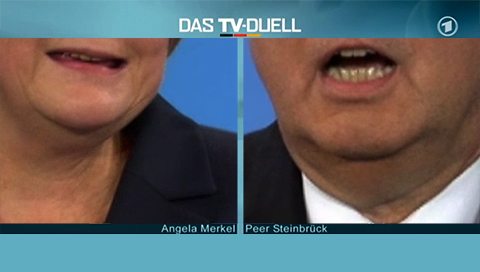1) “Zwischenlaute: Duell” (2014)
Duration: 13'49" (5.1 Surround sound)

Zwischenlaute is an audio work about editing, hesitation, and the human voice.
The sounds we make when we engage in speech can be divided into two
types: first, those phonemes and syllables that carry linguistic
meaning; second, any sounds to which no semantic value can be attached.
The second group includes stammers, false starts, the noises of
coughing and clearing the throat, and the filler sounds we pronounce,
often as "um" or "ah", to camouflage the moments of hesitation while we
think of what to say next. It is well understood by actors,
politicians, public speakers and professional salespeople that
excessive use of these fillers noises will put their listeners ill at
ease and that such sounds are best avoided. Since the advent of sound
recording in the twentieth century, a new technique is available to
those who cannot suppress these in-between-sounds: isolation and
excision of the undesirable noises by sound editing.
But why exactly are these sounds deemed undesirable? What are these
sounds, and why do they offend us so? Are they simply errors, momentary
malfunctions of the vocal apparatus? If so, what causes these
malfunctions? If not, is it possible that um's and ah's do not in fact
detract from communication but contribute to it in some way?
If the technology of sound editing allows us to eliminate these vocal
particles, it also allows us to isolate and study them in detail. When
we do so, we first may notice that representing these sounds as simply
“um” or “ah” is a woefully inadequate
transcription of the diversity they contain. They possess a richness of
melody, rhythm, and dynamic subtlety, none of which can be rendered in
written script. If we set aside the clinical listening technique of a
sound editor and open our ears to these sounds on their own merit, we
may often find them very beautiful and evocative. The paradox here is
that although these vocalizations are produced unintentionally, they
are often formally very complex: so complex in fact that to reproduce
the same sounds intentionally would demand a high level of virtuosity.
There is a kind of virtuosity, too, in the lightning-fast alternation
between fully-formed linguistic speech and these inarticulate moans and
groans, between eloquent mastery of thought and the wordless
desperation of not knowing what to say.
Upon closer listening to the sounds of vocal hesitation, I am struck by
the resemblance between these meaningless syllables and other
involuntary vocalizations brought on by various causes: the frightening
noises of epileptic seizures; the grunts of pain, fear, or extreme
panic; the vocal tics famously experienced by people with
Tourette’s syndrome; the unbridled exclamations of orgasm. Just
like these other types of involuntary vocal sounds, those caused by
hesitation in speech are without “signification” in the
linguistic sense. Nevertheless, they are highly expressive of emotion,
lending inflection to the speaker’s words, sometimes revealing
his or her attitude toward the subject at hand. This leads me to a
question I cannot answer: What is the mind thinking when the mouth is
stammering?
Although akin to stuttering, the behaviour of vocalization while
hesitating between words is not at all limited to subjects who would be
classified as stutterers by speech therapists. In compiling the
attached audio documentation giving examples of the types of sounds
that interest me, I found that virtually all speakers interject some
kind of meaningless noise into their speech. I myself constantly
produce these kinds of sounds when I speak. Perhaps we are all
stutterers, or perhaps a re-examination of what constitutes
“normal” speech is needed.
Here the advent of sound recording technique may have a decisive
influence on our perception of recorded speech. For if editing
introduces the capacity to suppress non-words from spoken discourse, is
it not also this capacity that focuses our attention on such errors
which previously were too fleeting to be noticed?
Zwischenlaute (“in-between sounds”) assembles a voluminous
collection of utterances representing moments of non-linguistic
hesitation – um’s, ah’s, stammers, false starts,
sonorous pauses. These noises will be taken from recordings of ordinary
speech and represent sounds an editor would usually delete from the
recording.
2) „Freedom Highway” (2001-2004, stereo)
 Duration: 24'36" (stereo)
Duration: 24'36" (stereo)
Link: http://www.freedomhighway.org
FREEDOM HIGHWAY is a project about mass media and American public
discourse. In the period between 9/11 and the start of the Iraq war, I
made numerous road trips through the United States. I covered thousands
of miles, burning tankloads of cheap American gasoline, surveying the
monoform landscape the U.S. interstate system has inscribed onto the
American landmass. I sat alone in my car, sharing the road with truck
drivers, commuters, vacationers and highway police troopers. Without a
particular destination in mind, my goal was to listen to and record
programming in the radio format known as talk radio.
The AM radio band in the US is a fascinating thing. Incredibly skewed
towards the right wing, talk radio's domination by ultra-conservatives
politically and evangelicals religiously has played a major role in
legitimizing and mainstreaming the ideological beliefs and policy
priorities dominant during the Bush administration and now expressed by
the Tea Party movement. Social scientists have noted this influence
since political talk radio gained prominence in the 1990s, studying the
demographics of the format's listenership and even positing a so-called
"Limbaugh effect" and its quantitative results in elections. While not
ignoring the persuasive power of the genre, my primary interest is in
talk radio as a cultural phenomenon.
In FREEDOM HIGHWAY, I liken talk radio to a national inner monologue:
what America says to itself when it thinks nobody else is listening.
The unique and defining social context of call-in radio is anonymity.
What callers say under cover of anonymity, just as what hosts say while
alone in the studio, is less inhibited than truly public speech. In
addition, the fact that talk radio's prime objective is to serve as
entertainment means that sensationalism and confrontation are
encouraged. While this may favor a discourse which tends towards
participants' basest and meanest instincts, it also affords a unique
and eye-opening insight into the demons and fears which animate some
part of the American psyche.
The piece is centered around a multi-voiced spoken narrative,
composited from hundreds of speakers recorded in about twenty states:
right-wing call-in hosts, radio preachers, shock jocks and sports
commentators as well as their guests and callers. Radio interference
and static are also used extensively throughout the piece to create
additional spaces besides the ones (radio studio and telephone)
inherent in the programming itself. The resulting audio footage is then
assembled into an audio performance and a gallery installation, a
deeply troubling “audio self-portrait” of America as
rendered by the nation’s political and religious radio
broadcasters, and as overheard or intercepted by a listener who is not
the intended audience of these broadcasts.
FREEDOM HIGHWAY has been performed, broadcast, and exhibited in gallery installation form
regularly since 2004. It has been heard in the US, Canada, and Europe.
(Emmanuel Madan)
3) “27’27’’” (2007)
Duration: 27’27” (5.1 Surround sound)

27’27” was the first result of an ongoing series of works
entitled H, an audio project articulating interplays between
electromagnetic field, sound, space, and bodies in movement. These
works are not intended as mere physical demonstrations of the
scientific properties of electromagnetism. Rather, the invite a
reflection on the idea that our actions are never without consequence.
We exist not just as observers but as active participants in complex
and constantly evolving fields of energy. Our every gesture, our very
presence, necessarily affect and are affected by these fields.
27’27” was composed from sound material generated solely by
applying human touch to audio cables that are plugged into amplifiers
on one end but unplugged on the other. Applying touch directly to the
exposed tip of a live audio cable yields a buzzing or humming sound
which should be familiar to anyone who has ever plugged cables into a
sound system or amplifier. Unremarkable as this phenomenon may seem,
the scientific explanation underlying it is fascinating and
unexpectedly poetic: a human body touching live audio wires effectively
becomes an antenna, picking up electromagnetic energy in the atmosphere
and translating
it into sound. A wide range of sounds can be produced simply by
modifying the pressure applied to the cable, varying the body’s
proximity to electromagnetic field-generating equipment, touching other
conductive materials such as metal, varying how much of the body is in
contact with the earth, or coming into contact with an additional human
body. By experimenting with these parameters, Madan developed a rich
sonic language for this composition.
Madan’s most recent work in the H series is Coupling (2014), a
sound installation/composition for variable-voltage lamp, guitar
amplifier, electronics, custom software and cables. Coupling is on view
until August 24, 2014, at the freiraum quartier21 / MuseumsQuartier
Wien as part
of the group exhibition Connecting Sound Etc. Cable Works, Cable Sounds, Cables Everywhere, curated by Georg Weckwerth.
|

 PLAY
PLAY


